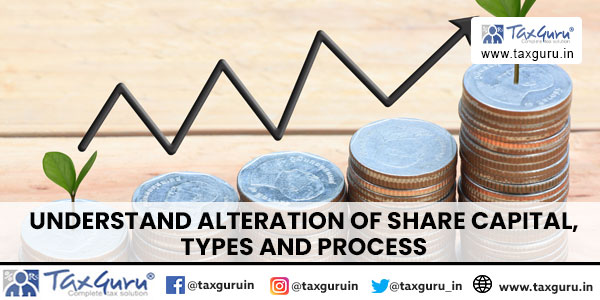Introduction
As the business expands, it could think about growing in terms of operations, size, scope, or structure. It might be necessary to infuse more cash into the company to realize that goal, which would increase share capital. Occasionally, the required capital may surpass the current allowable capital limit. Authorized capital is the maximum amount of capital for which the Company is permitted to issue Shares to its shareholders. In this article, we will delve into “What is Alteration of Share Capital?”, “Types of Alteration of Share Capital,” and “The Process for Alteration of Share Capital.”
The term “alteration of share capital” describes the act of changing the structure or composition of a company’s share capital. It involves changing the rights to existing share classes as well as the overall number of shares that the company issues. This change can be made in numerous ways, including dividing or consolidating current shares, changing the authorized share capital, or converting shares from one class to another. These changes may be made for many reasons, such as raising capital, redistributing ownership, or responding to evolving business requirements. The Articles of Association (AOA) must approve the Change in Share Capital Clause This is an important decision that needs to be made legally and by regulations to protect shareholder interests and uphold corporate transparency.
Section 61 of the Companies Act of 2013 states that the alteration in share capital can be done in 5 different ways:
- Spike In Authorized Capital:
Authorized capital can also be referred to as nominal or registered capital. This sum of money is required for establishing a business. The company may enhance its share capital by updating the Memorandum of Association’s capital clause.

- Consolidation of Shares:
This involves creating a single, bigger denomination share by combining multiple smaller denomination shares.
- Subdivision of Shares:
When a company splits up its existing shares into several smaller nominal-value shares, this is known as subdivision (or splitting of shares). This raises the number of outstanding shares, each with a lower market value, but does not affect the total value of the company’s share capital.
- Conversion of Shares
The conversion of shares into stock is the process by which a company unifies all of its fully paid-up shares into one indivisible share of stock. More flexibility in management and the transfer of ownership interests are possible.
- Shares Cancellation
The procedure through which a company takes its shares out of circulation permanently and so lowers its share capital is known as the cancellation of shares. The shares that are canceled are not reissued or resold, and this might happen through buybacks or redemption of shares. By raising the ownership proportion of surviving shareholders, this method can increase shareholder value.
Understand the Process for Alteration of Share Capital
Below are the sections involved in changing the Share Capital
Alteration in Article of Association
The set of guidelines that control the internal activities of the company are contained in the Articles of Association, which is a legal document. Therefore, it is necessary to check the Articles of Association to see if there is a clause allowing for an alteration in the authorized capital of the company before taking any action regarding the authorized capital.
We need to arrange a board meeting.
- A notice of the agenda will be sent to each director at their registered address at least seven days before the meeting.
- The agenda, date, time, and place of the meeting must be disclosed to the shareholders.
- To all directors, shareholders, and auditors, an extraordinary general meeting must be called.
- At least 21 days before the scheduled Extraordinary General Meeting, a notice of the meeting must be sent out.
- Only with the consent of at least 95% of the members eligible to vote at the meeting will a shorter notice period be granted.
Conducting an Extraordinary General Meeting:
Once the meeting has started, the subject of the increase in share capital is brought up. To decide the matter, voting then occurs in a predetermined order. The resolution is passed, and the appendix containing the explanation is added, after which the authorized capital is increased.
Registrar of Companies:
Within 30 days of the resolution being passed, the company must file eForm SH-7 and, if applicable, eForm MGT-14 with the Registrar, together with the required payments.
Conclusion
The process for Alteration of share capital is outlined in the Companies Act of 2013. The AoA and MoA must be altered to alter the company’s share capital. Investors in the company always benefit from an increase in total capital.





